A very old science fiction film, this is one of the classics. It's a 1927 black & white, silent film—though it's usually had a music and/or effect track dubbed onto it for recent releases (originally it would have had live accompaniment). And occasionally it's been tinted (some scenes washed with a colour, not fake colourising).
There's a few different versions of it floating around (with different sound tracks, and unadulterated gray or tinted monochrome pictures). And sometimes different running lengths (silent films ran at different speeds to modern films, and some film to video transfers are done at the wrong rate), as well as the film having been severely doctored over the years. But it runs for somewhere around ninety minutes to two hours, depending on which version you see.
It depicts a predicted future of our world, where there are two classes. A slave worker race, and overlords who live in luxury. Some of the doctoring of this film is likely to be due to political censorship, and I recall hearing that some attempts were made to destroy it.
The workers start to revolt, but one of the overlords has other ideas. He enlists the help of a mad scientist, who creates a human looking robot, to sabotage the worker's attempts to rid themselves of tyranny. Although, the robot was originally developed to be something to free people from having to do manual labour (not that you're given any idea about what would happen to the workers, who wouldn't have any work anymore). He kidnaps the woman who's motivating the workers to revolt, copies her body, and sends the robot out to crush the workers revolt.
We get to see the robot before he makes it human-like, and it has a very distinctive look to it (C3-P0, from the Star Wars films, was fashioned after this robot). The whole film has a bit of an Art Deco look to it, though that's not surprising as it is from the era that “Art Deco” came from.
For those who don't know what Art Deco means, that's the style seen on some of the older cinemas around Adelaide—The Picadilly, The Capri, and The Chelsea, to name a few—where you'll see rounded corners on the buildings architecture, and a very stylised thin type of writing (overall, it's a rather simple, or minimalistic, style). Alternatively, perhaps you might recognise it in the style of the building drawn under the 20th Century Fox logo.
Or to quote from our Macquarie Dictionary: A decorative style, originally of the 1920s and 1930s, characterised by rectilinear and streamlined forms and the innovative use of materials as plastic, glass, etc. [Art Déco, shortened form of Exposition Internationale des Arts Décoratifs, Paris, 1925]
The film has a lot of imagery, or symbolism. With many aspects of the plot portrayed in the look of every scene. Common enough to silent films, but this film has a very definite different look to many films. There's a very stylised look to everything, and the Art Deco architecture is very distinctive. Overall, the film's quite metaphorical.
The film was a flop on it's first release, though came to be one of the classics of its genre. The director, Fritz Lang, hated the ending of it, but Hitler and Goebbels (some of the worst people the world has ever known, to put it mildly) liked it enough to want Fritz Lang to produce films for them. He immediately fled Germany for Paris on the same day that they asked him, then he eventually went to Hollywood.
Different versions
There's several different versions of it that I know of, with different (added) sound tracks. Originally the film (itself) was silent, and would have had live musical accompaniment. These are different recent releases that I've seen or heard about:
-
A fairly watchable picture, accompanied with music played on piano and an organ (which sounds like a Hammond B3), and with percussive sound effects, all done in the traditional style of live accompaniments to silent films. The sound track's a little bit spooky or weird, in the right parts of the movie—it's not what you might call conventional music; but with some more conventional music styles for other parts of the movie. In some places the sound track is a bit more dramatic than the disc I recently bought (the scenes with the slave workers tending the machines, the creation of the robot, and the gong calling out for help during the flood). According to the information on my newly bought disc, there was a score composed specially for the entire film, and this version does actually use the correct score; albeit simplified, and not all of it.
This is the version that I first saw (it's about 90 minutes long), and would still like to get on DVD. If you know where I can get it from (preferably region 4, but definitely must be at Australian PAL/CCIR frame rates - 50 Hz and 15,625 kHz scan frequencies), then please contact me about it.
-
The film, tinted I believe, accompanied by various 1980's musical pop stars providing musical accompaniment (I think it's ones like the Eurythmics, Queen, etc.).
I've never seen this version (known as the Moroder version), and I don't think that I want to.
-
A poor quality picture, with crappy music (sounds like the music on a cheap American documentary about something really boring, where they've paid someone to sit at a cheap synthesiser and knock up some music in a hurry). It sounds crap, it's not interesting, it doesn't fit in with how music was written to accompany silent films, nor does it suit the scenes of the film it goes with. It's only there so that the film's not silent. The new musical soundtrack is credited to Peter Osborne, with a copyright date of 1998. It's 139 minutes long, according to the box.
If this is the version of the film that you prefer, though heck knows why, then make me an offer for the disc (the first one detailed below), as I'm so put off that I don't even want to watch it. I've only briefly skipped through it, enough to realise it's really dire.
-
A very well restored and re-orchestrated version. It's had some missing scenes replaced or explained (with inter-title cards), scenes that were hacked out to shorten the film, or censor it. It's had the effects of poor print copying tidied up, and has a great recording of an orchestra playing the original score composed for the film. As the opening notes say, the movie's been restored to as near as possible a condition as when it was seen at its premiere.
This is the version I just bought (the second one detailed below), it runs for a little under 2 hours. If you're a fan of the film, this is the version that you want.
A really dire version
I bought a copy on DVD from ezydvd.com.au, and was appalled to find that they're selling an incredibly crap version of Metropolis (a 139 minute, region 4 DVD, packaged by Eureka Video, and distributed by Force Video). I don't know what they were thinking, releasing a version like this. It's completely amateurish, the picture quality is even worse than the VHS copy I recorded from TV, and the music track is awful and completely inappropriate (it sounds like someone messing around on a Casio keyboard, and with all the lack of quality in the backing music as heard in recent pathetic attempts of reinventing classic television series like The Twilight Zone, or stupid documentaries trying to prove absurd claims). Don't buy this version, unless you're going to watch it with the sound turned completely off, and you can't find the better version on DVD.
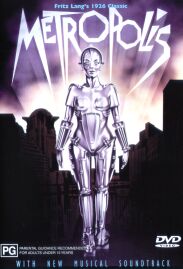 |
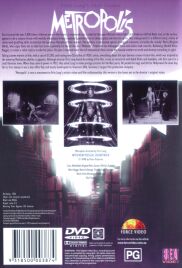 |
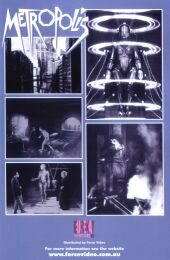 |
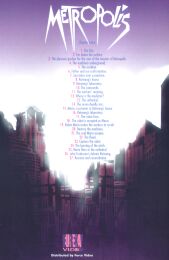 |
| Outside front cover | Outside back cover | Inside front cover | Inside back cover |
|---|
Copyright for the artwork scanned (above), belongs to the copyright owners (not me), reproduced without permission, as allowed for the purposes of study/review/critique of work, in limited amounts.
A really good version
More recently (October, 2004) I bought a much better version on DVD (again from ezydvd.com.au, but released by a different distributor, Madman entertainment, in July 2004). This one has a really good picture quality (no jumps, fuzzy, or flickery images), it's been copied properly (many old films looked so bad just because of the poor distribution copies, and mistreatment of them—some were originally very well shot). It's been restored to remove some of the damage, mutilation, and censorship (sometimes there's only a description of what cannot be replaced, done in the familiar style of a silent film's inter-title card). Purists might object that these aren't part of the original film, or that they're not written in the original German with extra English subtitles (for everyone else), but I can't read German, and I'm glad that I can follow the plot properly because the missing parts have been explained.
It, also, has a newly recorded orchestration of the original music score—and very nicely done too. Don't play this through just your TV speakers, you really have to plug it into your stereo system, or you just won't do it any justice. If you like classical music, perhaps opera or even ballet (some silent films are a bit like ballet, with choreographed and over-emphasised actions to push the emotion of a scene where the players cannot speak to you), or if you liked the music of Star Wars (for those with no experience with classical music), then you'll like the music that accompanies the pictures—you could, easily, enjoy the disc just for the music, and you'll probably notice parts of the music that seem familiar from other films. I've noticed parts that sound like they've been copied in the Superman movie theme, the 1960s Doctor Who movies with Peter Cushing, and Star Wars, just to name a few.
It's a two-disc set, the first disc is the movie (just under 2 hours long), and the second has a documentary, photos, and other notes. The movie has three sound tracks, there's a 5.1 surround and two-channel stereo version of the movie sound, and a narrated track. The narration is rather like listening to someone describe a ballet or opera on the radio; it's not the film restorers blathering on about the techniques that they, or the original producer, used on scenes—there's a separate documentary about that. The discs are held in place by far-less destructive hubs than many DVD boxes, and there's three more pictures printed on the innards of the packaging than I've shown below (Maria restrained in the copying machine, the new tower of Babel dominating the city of Metropolis, and the robot about to pull a lever on a machine's control panel).
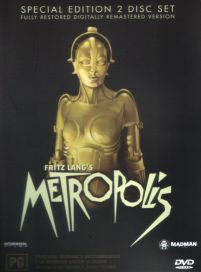 |
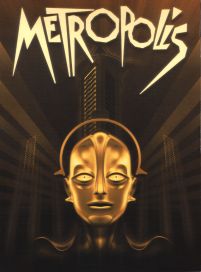 |
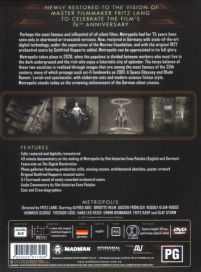 |
| Outer front cover | Inner front cover | Outer back cover |
|---|
Copyright for the artwork scanned (above), belongs to the copyright owners (not me), reproduced without permission, as allowed for the purposes of study/review/critique of work, in limited amounts.